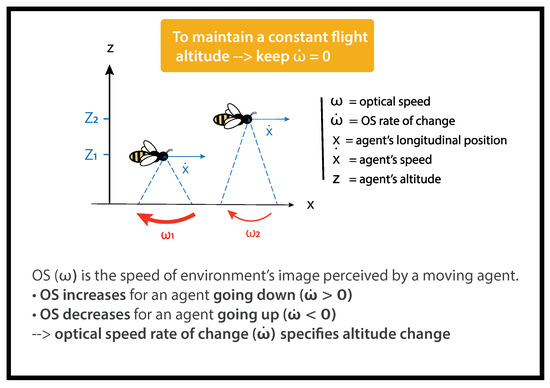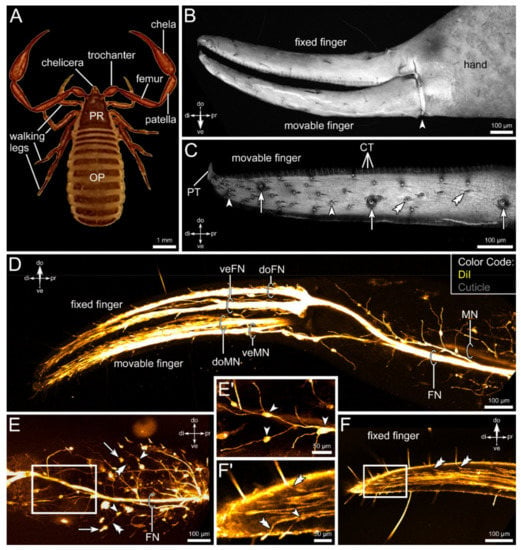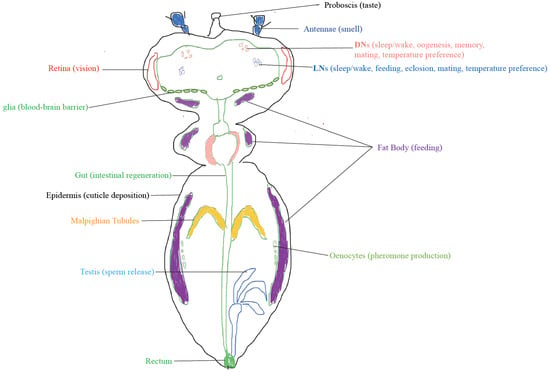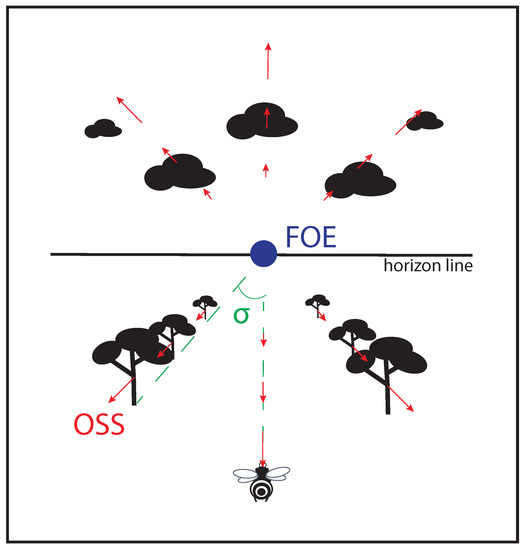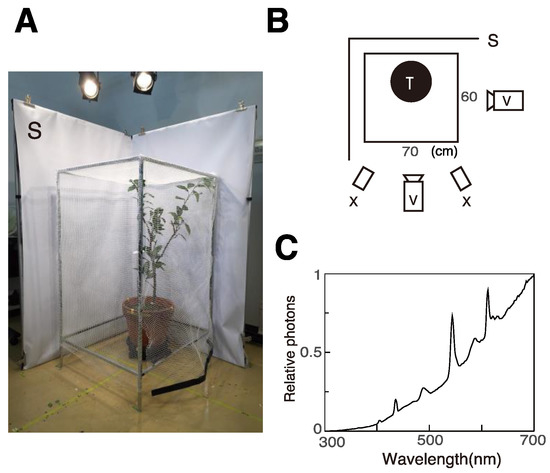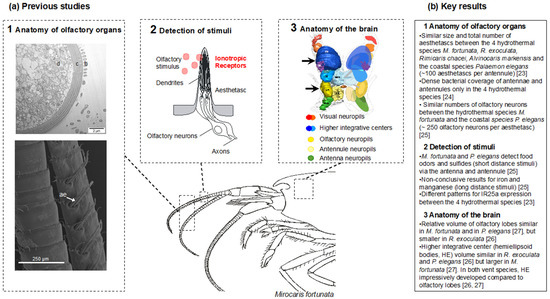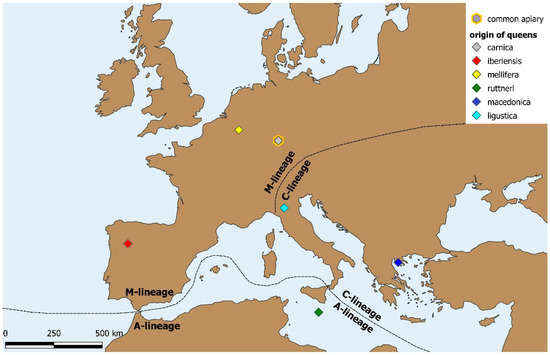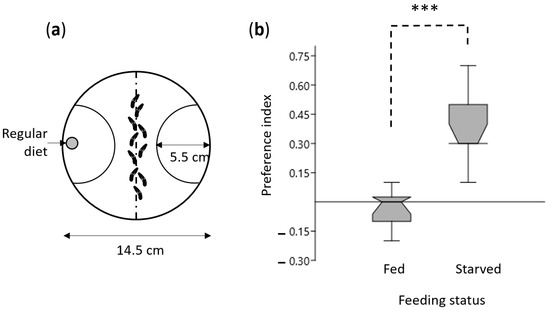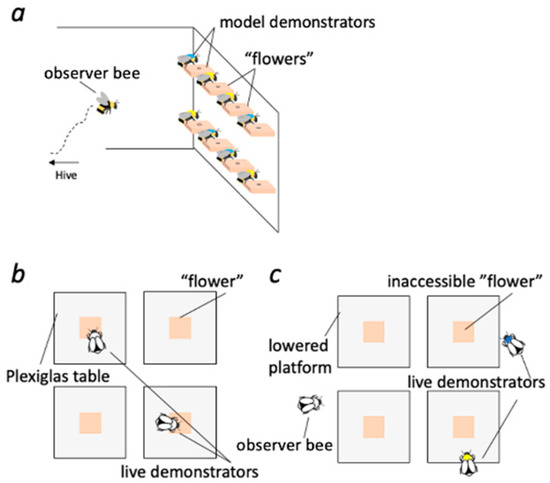Insect Senses: From Perception to Cognition
Share This Topical Collection
Editors
 Dr. Matthieu Dacher
Dr. Matthieu Dacher
 Dr. Matthieu Dacher
Dr. Matthieu Dacher
E-Mail
Website
Collection Editor
Institute for Ecology and Environmental Sciences of Paris, Sorbonne Universite, Paris, France
Interests: taste; nectar foraging; learning and memory; behavior; neuropharmacology
 Prof. Brian H. Smith
Prof. Brian H. Smith
 Prof. Brian H. Smith
Prof. Brian H. Smith
E-Mail
Website
Collection Editor
School of Life Sciences, Arizona State University, Tempe, AZ, USA
Interests: behavior; learning and memory; bioimaging; neurobiology; communication
Topical Collection Information
Dear Colleagues,
This Topical Collection aims to present a collection of articles representing outstanding contributions on insect perception and sensory integration. The tremendous diversity and ecological success of insects (and, more generally, arthropods) have been facilitated, among other factors, by their ability to use and integrate varied information. Such information covers all sensory modalities, including vision, chemical senses (olfaction and taste), mechanical senses (touching and hearing), and electric or magnetic perception. Moreover, perceived data are integrated with other information, allowing their manipulation through cognitive processes.
This Topical Collection will attempt to cover the diversity of sensory modalities in various arthropods, especially non-model insect species. All levels of integration are welcome, from molecular mechanisms of transduction to functional sensory ecology. Integrative and comparative approaches are particularly welcome.
Dr. Matthieu Dacher
Prof. Brian H. Smith
Collection Editors
Manuscript Submission Information
Manuscripts should be submitted online at www.mdpi.com by registering and logging in to this website. Once you are registered, click here to go to the submission form. Manuscripts can be submitted until the deadline. All submissions that pass pre-check are peer-reviewed. Accepted papers will be published continuously in the journal (as soon as accepted) and will be listed together on the collection website. Research articles, review articles as well as short communications are invited. For planned papers, a title and short abstract (about 100 words) can be sent to the Editorial Office for announcement on this website.
Submitted manuscripts should not have been published previously, nor be under consideration for publication elsewhere (except conference proceedings papers). All manuscripts are thoroughly refereed through a single-blind peer-review process. A guide for authors and other relevant information for submission of manuscripts is available on the Instructions for Authors page. Insects is an international peer-reviewed open access monthly journal published by MDPI.
Please visit the Instructions for Authors page before submitting a manuscript.
The Article Processing Charge (APC) for publication in this open access journal is 2600 CHF (Swiss Francs).
Submitted papers should be well formatted and use good English. Authors may use MDPI's
English editing service prior to publication or during author revisions.
Keywords
- perception
- integration
- cognition
- sensory organs
- vision
- olfaction
- taste
- hearing
- touching
- other sensory modalities
Published Papers (12 papers)
Open AccessArticle
Antennal Transcriptome Evaluation and Analysis for Odorant-Binding Proteins, Chemosensory Proteins, and Suitable Reference Genes in the Leaf Beetle Pest Diorhabda rybakowi Weise (Coleoptera: Chrysomelidae)
by
Bo-Xin Xi, Xiao-Ning Cui, Su-Qin Shang, Guang-Wei Li, Youssef Dewer, Chang-Ning Li, Gui-Xin Hu and Yan Wang
Viewed by 1674
Abstract
Diorhabda rybakowi Weise is one of the dominant pests feeding on
Nitraria spp., a pioneer plant used for windbreaking and sand fixation purposes, and poses a threat to local livestock and ecosystems. To clarify the key olfactory genes of
D. rybakowi and provide
[...] Read more.
Diorhabda rybakowi Weise is one of the dominant pests feeding on
Nitraria spp., a pioneer plant used for windbreaking and sand fixation purposes, and poses a threat to local livestock and ecosystems. To clarify the key olfactory genes of
D. rybakowi and provide a theoretical basis for attractant and repellent development, the optimal reference genes under two different conditions (tissue and sex) were identified, and the bioinformatics and characterization of the tissue expression profiles of two categories of soluble olfactory proteins (OBPs and CSPs) were investigated. The results showed that the best reference genes were
RPL13a and
RPS18 for comparison among tissues, and
RPL19 and
RPS18 for comparison between sexes. Strong expressions of
DrybOBP3,
DrybOBP6,
DrybOBP7,
DrybOBP10,
DrybOBP11,
DrybCSP2, and
DrybCSP5 were found in antennae, the most important olfactory organ for
D. rybakowi. These findings not only provide a basis for further in-depth research on the olfactory molecular mechanisms of host-specialized pests but also provide a theoretical basis for the future development of new chemical attractants or repellents using volatiles to control
D. rybakowi.
Full article
►▼
Show Figures
Open AccessArticle
Honeybees Use Multiple Invariants to Control Their Altitude
by
Aimie Berger Dauxère, Gilles Montagne and Julien R. Serres
Viewed by 1551
Abstract
How do bees perceive altitude changes so as to produce safe displacements within their environment? It has been proved that humans use invariants, but this concept remains little-known within the entomology community. The use of a single invariant, the optical speed rate of
[...] Read more.
How do bees perceive altitude changes so as to produce safe displacements within their environment? It has been proved that humans use invariants, but this concept remains little-known within the entomology community. The use of a single invariant, the optical speed rate of change, has been extensively demonstrated in bees in a ground-following task. Recently, it has been demonstrated that another invariant, the splay angle rate of change, could also be used by bees to adjust their altitude. This study aims to understand how bees use these invariants when they are available simultaneously. This issue has been addressed using an experimental setup providing discordant information to bees. We have shown that when the two invariants were available, bees performed ground-following tasks relying primarily on optical speed rate of change. Conversely, when optical speed rate of change was less easily accessible, splay angle rate of change was prioritized, unless the bees perceive danger. Taken together, these results illustrate how the joint use of several invariants allows bees to produce adaptive behaviors.
Full article
►▼
Show Figures
Open AccessArticle
Exploring Higher-Order Conceptual Learning in an Arthropod with a Large Multisensory Processing Center
by
Kenna D. S. Lehmann, Fiona G. Shogren, Mariah Fallick, James Colton Watts, Daniel Schoenberg, Daniel D. Wiegmann, Verner P. Bingman and Eileen A. Hebets
Cited by 2 | Viewed by 2610
Abstract
Comparative cognition aims to understand the evolutionary history and current function of cognitive abilities in a variety of species with diverse natural histories. One characteristic often attributed to higher cognitive abilities is higher-order conceptual learning, such as the ability to learn concepts independent
[...] Read more.
Comparative cognition aims to understand the evolutionary history and current function of cognitive abilities in a variety of species with diverse natural histories. One characteristic often attributed to higher cognitive abilities is higher-order conceptual learning, such as the ability to learn concepts independent of stimuli—e.g., ‘same’ or ‘different’. Conceptual learning has been documented in honeybees and a number of vertebrates. Amblypygids, nocturnal enigmatic arachnids, are good candidates for higher-order learning because they are excellent associational learners, exceptional navigators, and they have large, highly folded mushroom bodies, which are brain regions known to be involved in learning and memory in insects. In Experiment 1, we investigate if the amblypygid
Phrynus marginimaculatus can learn the concept of same with a delayed odor matching task. In Experiment 2, we test if
Paraphrynus laevifrons can learn same/different with delayed tactile matching and nonmatching tasks before testing if they can transfer this learning to a novel cross-modal odor stimulus. Our data provide no evidence of conceptual learning in amblypygids, but more solid conclusions will require the use of alternative experimental designs to ensure our negative results are not simply a consequence of the designs we employed.
Full article
►▼
Show Figures
Open AccessEditor’s ChoiceArticle
Anatomy of the Nervous System in Chelifer cancroides (Arachnida: Pseudoscorpiones) with a Distinct Sensory Pathway Associated with the Pedipalps
by
Torben Stemme and Sarah E. Pfeffer
Cited by 9 | Viewed by 5027
Abstract
Many arachnid taxa have evolved unique, highly specialized sensory structures such as antenniform legs in Amblypygi (whip spiders), for instance, or mesosomal pectines in scorpions. Knowledge of the neuroanatomy as well as functional aspects of these sensory organs is rather scarce, especially in
[...] Read more.
Many arachnid taxa have evolved unique, highly specialized sensory structures such as antenniform legs in Amblypygi (whip spiders), for instance, or mesosomal pectines in scorpions. Knowledge of the neuroanatomy as well as functional aspects of these sensory organs is rather scarce, especially in comparison to other arthropod clades. In pseudoscorpions, no special sensory structures have been discovered so far. Nevertheless, these animals possess dominant, multifunctional pedipalps, which are good candidates for being the primary sensory appendages. However, only little is known about the anatomy of the nervous system and the projection pattern of pedipalpal afferents in this taxon. By using immunofluorescent labeling of neuronal structures as well as lipophilic dye labeling of pedipalpal pathways, we identified the arcuate body, as well as a comparatively small mushroom body, the latter showing some similarities to that of Solifugae (sun spiders and camel spiders). Furthermore, afferents from the pedipalps terminate in a glomerular and a layered neuropil. Due to the innervation pattern and structural appearance, we conclude that these neuropils are the first integration centers of the chemosensory and mechanosensory afferents. Within Arthropoda, but also other invertebrates or even vertebrates, sensory structures show rather similar neuronal arrangement. Thus, these similarities in the sensory systems of different evolutionary origin have to be interpreted as functional prerequisites of the respective modality.
Full article
►▼
Show Figures
Open AccessReview
Perception of Daily Time: Insights from the Fruit Flies
by
Joydeep De and Abhishek Chatterjee
Cited by 1 | Viewed by 4233
Abstract
We create mental maps of the space that surrounds us; our brains also compute time—in particular, the time of day. Visual, thermal, social, and other cues tune the clock-like timekeeper. Consequently, the internal clock synchronizes with the external day-night cycles. In fact, daylength
[...] Read more.
We create mental maps of the space that surrounds us; our brains also compute time—in particular, the time of day. Visual, thermal, social, and other cues tune the clock-like timekeeper. Consequently, the internal clock synchronizes with the external day-night cycles. In fact, daylength itself varies, causing the change of seasons and forcing our brain clock to accommodate layers of plasticity. However, the core of the clock, i.e., its molecular underpinnings, are highly resistant to perturbations, while the way animals adapt to the daily and annual time shows tremendous biological diversity. How can this be achieved? In this review, we will focus on 75 pairs of clock neurons in the Drosophila brain to understand how a small neural network perceives and responds to the time of the day, and the time of the year.
Full article
►▼
Show Figures
Open AccessReview
Ecological Entomology: How Is Gibson’s Framework Useful?
by
Aimie Berger Dauxère, Julien R. Serres and Gilles Montagne
Cited by 5 | Viewed by 4086
Abstract
To date, numerous studies have demonstrated the fundamental role played by optic flow in the control of goal-directed displacement tasks in insects. Optic flow was first introduced by Gibson as part of their ecological approach to perception and action. While this theoretical approach
[...] Read more.
To date, numerous studies have demonstrated the fundamental role played by optic flow in the control of goal-directed displacement tasks in insects. Optic flow was first introduced by Gibson as part of their ecological approach to perception and action. While this theoretical approach (as a whole) has been demonstrated to be particularly suitable for the study of goal-directed displacements in humans, its usefulness in carrying out entomological field studies remains to be established. In this review we would like to demonstrate that the ecological approach to perception and action could be relevant for the entomologist community in their future investigations. This approach could provide a conceptual and methodological framework for the community in order to: (i) take a critical look at the research carried out to date, (ii) develop rigorous and innovative experimental protocols, and (iii) define scientific issues that push the boundaries of the current scientific field. After a concise literature review about the perceptual control of displacement in insects, we will present the framework proposed by Gibson and suggest its added value for carrying out research in the field of behavioral ecology in insects.
Full article
►▼
Show Figures
Open AccessArticle
Swallowtail Butterflies Use Multiple Visual Cues to Select Oviposition Sites
by
Hiromi Nagaya, Finlay J. Stewart and Michiyo Kinoshita
Cited by 9 | Viewed by 2698
Abstract
Flower-foraging Japanese yellow swallowtail butterflies,
Papilio xuthus, exhibit sophisticated visual abilities. When ovipositing, females presumably attempt to select suitable leaves to support the growth of their larval offspring. We first established that butterflies indeed select particular leaves on which to lay
[...] Read more.
Flower-foraging Japanese yellow swallowtail butterflies,
Papilio xuthus, exhibit sophisticated visual abilities. When ovipositing, females presumably attempt to select suitable leaves to support the growth of their larval offspring. We first established that butterflies indeed select particular leaves on which to lay eggs; when presented with a single
Citrus tree, butterflies significantly favored two out of 102 leaves for oviposition. These preferences were observed across many individuals, implying that they were not merely idiosyncratic, but rather based on properties of the leaves in question. Because the butterflies descended towards the leaves rather directly from a distance, we hypothesized that they base their selection on visual cues. We measured five morphological properties (height, orientation, flatness, roundness, and size) and four reflective features (green reflectance, brightness, and degree and angle of linear polarization). We found that the number of eggs laid upon a leaf was positively correlated with its height, flatness, green reflectance, and brightness, and negatively correlated with its degree of polarization, indicating that these features may serve as cues for leaf selection. Considering that other studies report ovipositing butterflies’ preference for green color and horizontally polarized light, butterflies likely use multiple visual features to select egg-laying sites on the host plant.
Full article
►▼
Show Figures
Open AccessArticle
Do Hydrothermal Shrimp Smell Vents?
by
Juliette Ravaux, Julia Machon, Bruce Shillito, Dominique Barthélémy, Louis Amand, Mélanie Cabral, Elise Delcour and Magali Zbinden
Cited by 3 | Viewed by 3471
Abstract
Deep-sea species endemic to hydrothermal vents face the critical challenge of detecting active sites in a vast environment devoid of sunlight. This certainly requires specific sensory abilities, among which olfaction could be a relevant sensory modality, since chemical compounds in hydrothermal fluids or
[...] Read more.
Deep-sea species endemic to hydrothermal vents face the critical challenge of detecting active sites in a vast environment devoid of sunlight. This certainly requires specific sensory abilities, among which olfaction could be a relevant sensory modality, since chemical compounds in hydrothermal fluids or food odors could potentially serve as orientation cues. The temperature of the vent fluid might also be used for locating vent sites. The objective of this study is to observe the following key behaviors of olfaction in hydrothermal shrimp, which could provide an insight into their olfactory capacities: (1) grooming behavior; (2) attraction to environmental cues (food odors and fluid markers). We designed experiments at both deep-sea and atmospheric pressure to assess the behavior of the vent shrimp
Rimicaris exoculata and
Mirocaris fortunata, as well as of the coastal species
Palaemon elegans and
Palaemon serratus for comparison. Here, we show that hydrothermal shrimp groom their sensory appendages similarly to other crustaceans, but this does not clean the dense bacterial biofilm that covers the olfactory structures. These shrimp have previously been shown to possess functional sensory structures, and to detect the environmental olfactory signals tested, but we do not observe significant attraction behavior here. Only temperature, as a signature of vent fluids, clearly attracts vent shrimp and thus is confirmed to be a relevant signal for orientation in their environment.
Full article
►▼
Show Figures
Open AccessArticle
Synaptic Interactions in Scorpion Peg Sensilla Appear to Maintain Chemosensory Neurons within Dynamic Firing Range
by
Douglas D. Gaffin and Safra F. Shakir
Cited by 8 | Viewed by 3001
Abstract
Scorpions have elaborate chemo-tactile organs called pectines on their ventral mesosoma. The teeth of the comb-like pectines support thousands of minute projections called peg sensilla (a.k.a. “pegs”), each containing approximately 10 chemosensory neurons. Males use pectines to detect pheromones released by females, and
[...] Read more.
Scorpions have elaborate chemo-tactile organs called pectines on their ventral mesosoma. The teeth of the comb-like pectines support thousands of minute projections called peg sensilla (a.k.a. “pegs”), each containing approximately 10 chemosensory neurons. Males use pectines to detect pheromones released by females, and both sexes apparently use pectines to find prey and navigate to home retreats. Electrophysiological recordings from pegs of
Paruroctonus utahensis reveal three spontaneously active cells (A
1, A
2, and B), which appear to interact synaptically. We made long-term extracellular recordings from the bases of peg sensilla and used a combination of conditional cross-interval and conditional interspike-interval analyses to assess the temporal dynamics of the A and B spike trains. Like previous studies, we found that A cells are inhibited by B cells for tens of milliseconds. However, after normalizing our records, we also found clear evidence that the A cells excite the B cells. This simple local circuit appears to maintain the A cells in a dynamic firing range and may have important implications for tracking pheromonal trails and sensing substrate chemistry for navigation.
Full article
►▼
Show Figures
Open AccessArticle
Comparing the Appetitive Learning Performance of Six European Honeybee Subspecies in a Common Apiary
by
Ricarda Scheiner, Kayun Lim, Marina D. Meixner and Martin S. Gabel
Cited by 3 | Viewed by 2562
Abstract
The Western honeybee (
Apis mellifera L.) is one of the most widespread insects with numerous subspecies in its native range. How far adaptation to local habitats has affected the cognitive skills of the different subspecies is an intriguing question that we investigate
[...] Read more.
The Western honeybee (
Apis mellifera L.) is one of the most widespread insects with numerous subspecies in its native range. How far adaptation to local habitats has affected the cognitive skills of the different subspecies is an intriguing question that we investigate in this study. Naturally mated queens of the following five subspecies from different parts of Europe were transferred to Southern Germany:
A. m. iberiensis from Portugal,
A. m. mellifera from Belgium,
A. m. macedonica from Greece,
A. m. ligustica from Italy, and
A. m. ruttneri from Malta. We also included the local subspecies
A. m. carnica in our study. New colonies were built up in a common apiary where the respective queens were introduced. Worker offspring from the different subspecies were compared in classical olfactory learning performance using the proboscis extension response. Prior to conditioning, we measured individual sucrose responsiveness to investigate whether possible differences in learning performances were due to differential responsiveness to the sugar water reward. Most subspecies did not differ in their appetitive learning performance. However, foragers of the Iberian honeybee,
A. m. iberiensis, performed significantly more poorly, despite having a similar sucrose responsiveness. We discuss possible causes for the poor performance of the Iberian honeybees, which may have been shaped by adaptation to the local habitat.
Full article
►▼
Show Figures
Open AccessArticle
Transcriptome Profiling of Starvation in the Peripheral Chemosensory Organs of the Crop Pest Spodoptera littoralis Caterpillars
by
Erwan Poivet, Aurore Gallot, Nicolas Montagné, Pavel Senin, Christelle Monsempès, Fabrice Legeai and Emmanuelle Jacquin-Joly
Cited by 4 | Viewed by 3308
Abstract
Starvation is frequently encountered by animals under fluctuating food conditions in nature, and response to it is vital for life span. Many studies have investigated the behavioral and physiological responses to starvation. In particular, starvation is known to induce changes in olfactory behaviors
[...] Read more.
Starvation is frequently encountered by animals under fluctuating food conditions in nature, and response to it is vital for life span. Many studies have investigated the behavioral and physiological responses to starvation. In particular, starvation is known to induce changes in olfactory behaviors and olfactory sensitivity to food odorants, but the underlying mechanisms are not well understood. Here, we investigated the transcriptional changes induced by starvation in the chemosensory tissues of the caterpillar
Spodoptera littoralis, using Illumina RNA sequencing. Gene expression profiling revealed 81 regulated transcripts associated with several biological processes, such as glucose metabolism, immune defense, response to stress, foraging activity, and olfaction. Focusing on the olfactory process, we observed changes in transcripts encoding proteins putatively involved in the peri-receptor events, namely, chemosensory proteins and odorant-degrading enzymes. Such modulation of their expression may drive fluctuations in the dynamics and the sensitivity of the olfactory receptor neuron response. In combination with the enhanced presynaptic activity mediated via the short neuropeptide F expressed during fasting periods, this could explain an enhanced olfactory detection process. Our observations suggest that a coordinated transcriptional response of peripheral chemosensory organs participates in the regulation of olfactory signal reception and olfactory-driven behaviors upon starvation.
Full article
►▼
Show Figures
Open AccessArticle
Foraging Bumblebees Selectively Attend to Other Types of Bees Based on Their Reward-Predictive Value
by
Jose E. Romero-González, Amanda L. Royka, HaDi MaBouDi, Cwyn Solvi, Janne-Tuomas Seppänen and Olli J. Loukola
Cited by 3 | Viewed by 4786
Abstract
Using social information can be an efficient strategy for learning in a new environment while reducing the risks associated with trial-and-error learning. Whereas social information from conspecifics has long been assumed to be preferentially attended by animals, heterospecifics can also provide relevant information.
[...] Read more.
Using social information can be an efficient strategy for learning in a new environment while reducing the risks associated with trial-and-error learning. Whereas social information from conspecifics has long been assumed to be preferentially attended by animals, heterospecifics can also provide relevant information. Because different species may vary in their informative value, using heterospecific social information indiscriminately can be ineffective and even detrimental. Here, we evaluated how selective use of social information might arise at a proximate level in bumblebees (
Bombus terrestris) as a result of experience with demonstrators differing in their visual appearance and in their informative value as reward predictors. Bumblebees were first trained to discriminate rewarding from unrewarding flowers based on which type of “heterospecific” (one of two differently painted model bees) was next to each flower. Subsequently, these bumblebees were exposed to a novel foraging context with two live painted bees. In this novel context, observer bumblebees showed significantly more social information-seeking behavior towards the type of bees that had predicted reward during training. Bumblebees were not attracted by paint-marked small wooden balls (moved via magnets) or paint-marked non-pollinating heterospecifics (woodlice;
Porcellio laevis) in the novel context, indicating that bees did not simply respond to conditioned color cues nor to irrelevant social cues, but rather had a “search image” of what previously constituted a valuable, versus invaluable, information provider. The behavior of our bumblebees suggests that their use of social information is governed by learning, is selective, and extends beyond conspecifics.
Full article
►▼
Show Figures








